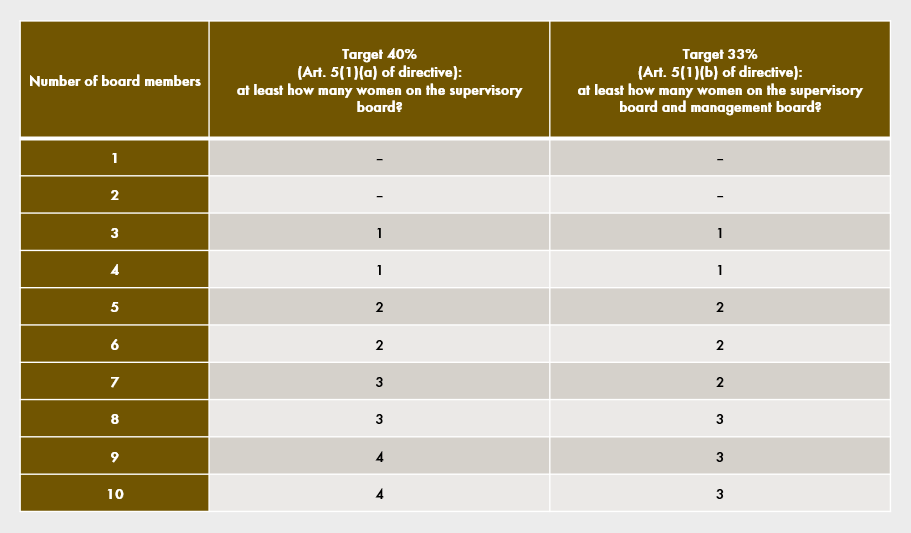Green light for women on the boards of listed companies
In recent years, ESG has been mainly about “E”—environmental aspects, which were most often subject to regulation. Now there is increasing emphasis on social (S) and corporate governance (G). A noteworthy measure in governance is the EU’s Gender Balance Directive, which came into force at the end of 2022. The directive is intended to ensure more balanced representation of women and men among directors of listed companies.
Although EU law prohibits gender discrimination and research finds that gender balance has a positive impact on companies, women are still underrepresented at the highest levels of management. According to the European Institute for Gender Equality (EIGE), in April 2022, in the largest listed companies, women made up an average of 32% of board members and 8% of CEOs (Gender Equality Index 2022). This demonstrates a need to implement measures to foster women’s professional development and achieve gender-balanced representation in top positions. Such measures are provided for in Directive (EU) 2022/2381 on improving gender balance among directors of listed companies and related measures.
The scope of the directive
The directive applies to listed companies, i.e. companies with a registered office in an EU member state whose shares are admitted to trading on a regulated market in at least one member state. The directive does not cover micro, small or medium-sized enterprises.
The directive applies to listed companies meeting the following criteria:
- At least 250 employees, and either
- At least EUR 50 million (or equivalent) in annual turnover, or
- At least EUR 43 million (or equivalent) balance sheet total.
The directive applies only to listed companies (reaching the above thresholds), as listed companies are of exceptional economic importance and have a special social responsibility. They are considered a model for other companies, and their public nature justifies imposing more demanding regulations on them than on other companies.
Targets for gender balance in corporate boards
Under the directive, member states must require listed companies to meet one of two targets by 30 June 2026:
- Members of the underrepresented sex must hold at least 40% of non-executive director positions (Art. 5.1(a) of the directive), or
- Members of the underrepresented sex must hold at least 33% of all director positions, including both executive and non-executive directors (Art. 5(1)(b) of the directive).
In the reality of Polish joint-stock companies, a non-executive director would be a member of the supervisory board and an executive director would be a member of the management board.
Although the directive indicates specific numerical thresholds, it states at the same time that:
- The percentage of non-executive director positions occupied by the underrepresented sex is to be closest to the proportion of 40% but not to exceed 49%
- The percentage of all director positions occupied by the underrepresented sex is to be closest to the proportion of 33% but not to exceed 49%.
A chart with numerical figures is given in the Annex to the directive:

***
Example:
There are three people on the management board of a listed company and five on its supervisory board. To achieve the minimum numerical targets under the directive, members of the underrepresented sex should account for:
- At least two members of the supervisory board (target of Art. 5(1)(a) of the directive), or
- At least three members jointly on the management board and the supervisory board (target of Art. 5(1)(b) of the directive).
***
The directive sets minimum requirements, which means that the member states can introduce or maintain regulations ensuring an even more balanced representation of women and men on listed companies’ boards.
But if a member state does not impose an obligation on listed companies to meet the target from Art. 5(1)(b) of the directive (regarding all directors, i.e. both non-executive and executive directors), those companies should still be required to set individual targets by 30 June 2026, with a view to improving gender balance among executive directors.
Reporting, sanctions, and transposition of the directive
The directive also provides for reporting obligations. Member states are to require listed companies to report annually to the relevant authorities on gender representation on their boards.
Additionally, member states are to impose sanctions when listed companies violate national regulations adopted under selected provisions of the directive. This has to do with situations where listed companies:
- Do not set individual targets regarding executive directors when no obligation has been imposed on them to meet the target for non-executive and executive directors (i.e. from Art. 5(1)(b) of the directive)
- Fail to modify the selection process for director candidates when they fail to achieve the targets from Art. 5(1)(a) and (b) of the directive
- Do not comply with reporting obligations under the directive.
The sanctions can include fines or the possibility of annulling the appointment of directors.
According to the directive, listed companies are to achieve certain targets by 30 June 2026, while the member states are to adopt and publish provisions necessary to implement the directive by 28 December 2024.
Summary
In the European Union, statistics show that corporate boards are characterised by gender imbalance. For many years, not enough action has been taken at the EU level to change this situation. In 2012, the European Commission presented a proposal for a directive on improving the gender balance among directors of listed companies, but work on the directive was stalled in the Council for almost 10 years. The prevailing stereotypes defining the traditional roles of men and women are still a difficult barrier to overcome, but the Gender Balance Directive may ultimately succeed in doing this at the highest levels of corporate management.
Julia Dolna, attorney-at-law, M&A and Corporate practice, Wardyński & Partners
